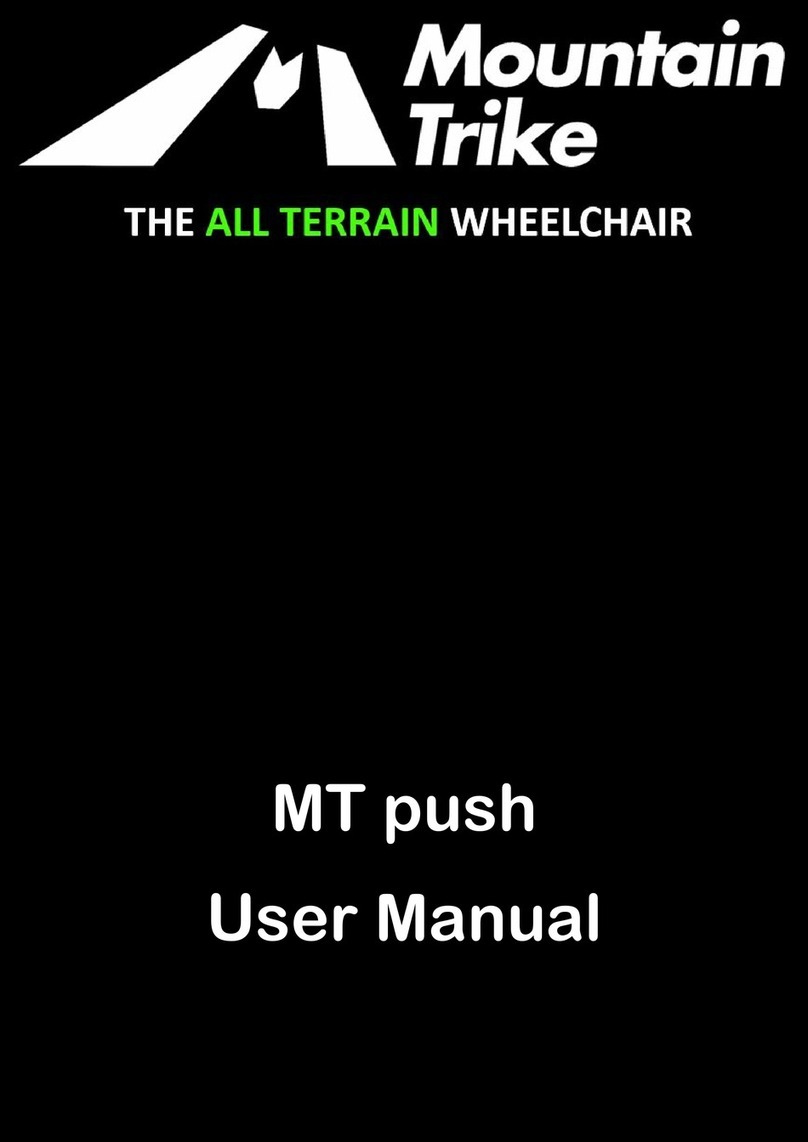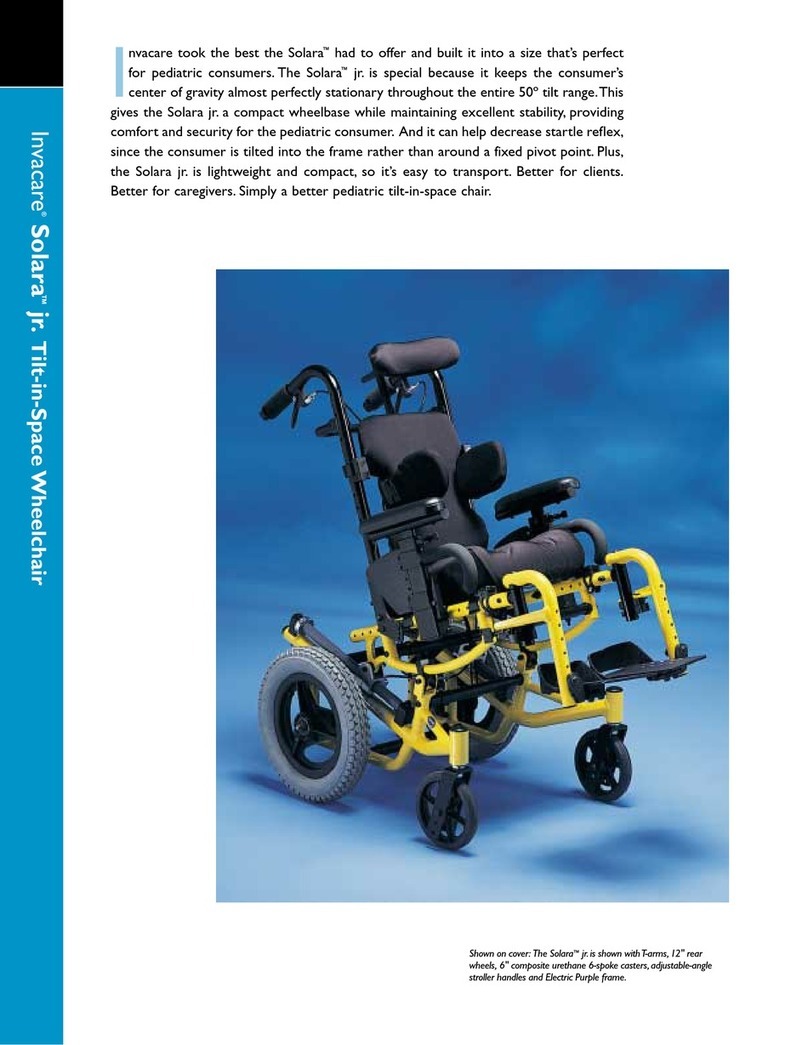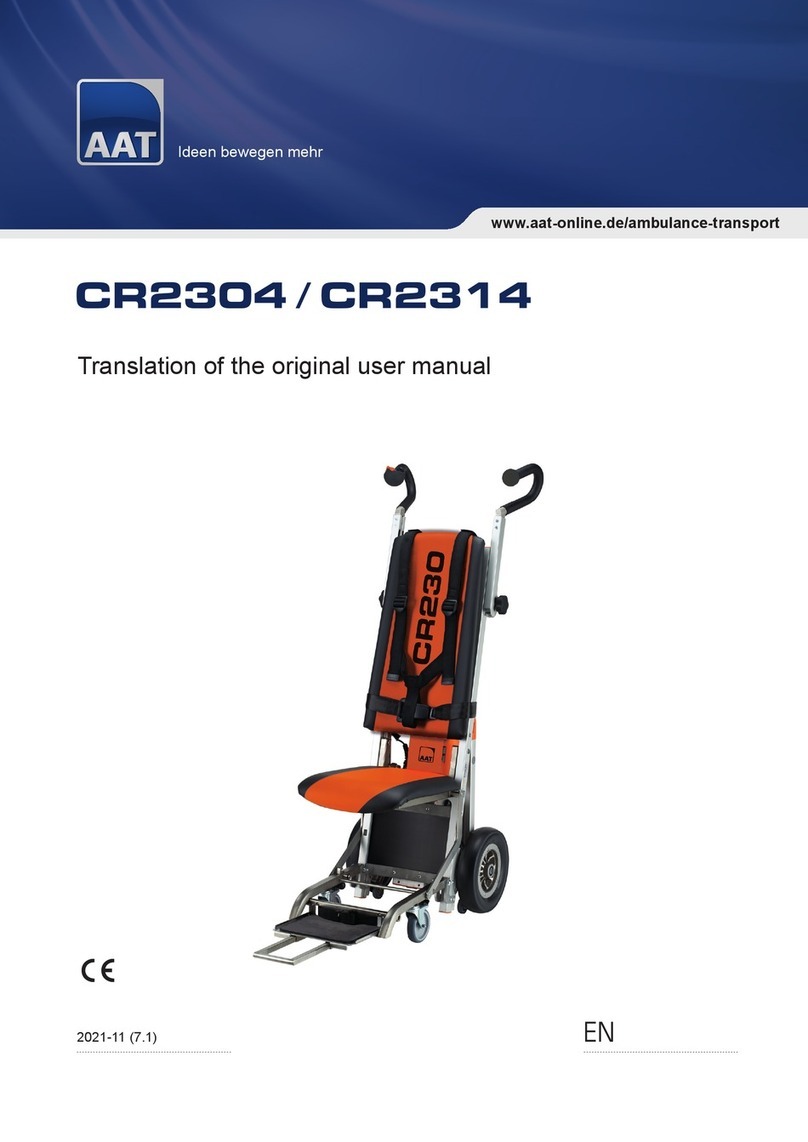Mountain Trike MT3.001.0001 User manual


Mountain Trike Owner’s Manual Issue 2
2

Mountain Trike Owner’s Manual Issue 2
3
Mountain Trike Owner’s Manual
1st Edition 2011
This manual is designed to meet EN Standards 12182, 12183, 14971
IMPORTANT:
This owner’s manual contains important safety, performance and service
information. Please read it before you take the first ride on your new Mountain
Trike and keep it for reference.
Additional safety, performance and service information for specific components
such as the suspension on your Mountain Trike may also be available. Make sure
that your dealer has given you all the manufacturers’ literature that was included
with your Mountain Trike; a complete list can be found on page 9. In case of a
conflict between the instructions in this manual and information provided by a
component manufacturer, always follow the component manufacturer’s
instructions.
If you have any questions or do not understand something, take responsibility for
your safety and consult with your dealer.
NOTE:
This manual is not intended as a comprehensive use, service, repair or
maintenance manual. Please see your Mountain Trike dealer for all service,
repairs or maintenance.
Mountain Trike Frame Number
Mountain Trike Order Number
Date of Purchase

Mountain Trike Owner’s Manual Issue 2
4
Introduction
Congratulations! You now possess one of the finest all terrain wheelchairs in the world. The
following pages will provide you with the information you need to properly use, adjust and
maintain your new Mountain Trike, so you can get the most out of every ride.
It is essential that you read this owner’s manual thoroughly before riding your Mountain Trike, we
know you’re anxious to get riding, but it will only take a few minutes, and then you can unleash
the full potential of your Mountain Trike.
Please pay special attention to the safety information and cautions shown throughout this
owner’s manual.
If you encounter any issues with your Mountain Trike that aren’t covered in this manual, please
contact your nearest Authorized Mountain Trike Dealer. As your number one resource, your
Mountain Trike dealer can answer questions, perform required maintenance and recommend the
best equipment to complement your ride.
Thank you for buying a Mountain Trike!
Enjoy the ride!
All diagrams included in this manual are based on a right hand steering Mountain Trike, although
left handed steering options are also available at your Mountain Trike dealer.

Mountain Trike Owner’s Manual Issue 2
5
Table of Contents
Introduction 4
A word about warnings, accidents and safety 6
Think Safety 7
A Special Note for Parents 7
Your Mountain Trike 8
1.0 Setting up your Mountain Trike 8
1.1 Intended Operator 8
Frame Size 9
Arm Reach 9
1.2 Assembly and Disassembly for Storage 10
Seat Folding 11
Folding the Rear Wheel 11
Drive Module Removal 13
Removal of Rear Wheel Steering Cable Attachment 15
Footrest and Anti-tip Wheel Adjustment 15
2.0 Riding instructions 16
2.1 Pre-Ride Mechanical Safety Checks 16
Suspension 17
Tyre Pressures 17
2.2 Transferring in and out 17
2.3 How to Engage / Disengage Drive 19
2.4 Forward Drive 20
2.5 Reverse Drive 20
2.6 Steering 21
2.7 Braking 22
Anti-Tip Wheels 22
2.8 Hill and Kerb Climbing 22
2.9 Descending Slopes 23
3.0 The Safety Bit 24
3.1 Riding safely about town 24
3.2 Riding safely Off Road 25
3.3 Wet Weather Riding 26
3.4 Night Riding 26
3.5 Extreme riding 26
3.6 Adding Accessories and Changing Components 27
4.0 Service 28
4.1 Looking After Your Mountain Trike 28
Drive 29
Brakes 30
Steering 30
Frame and Seat 31
4.2 Maintenance Schedule 32
4.3 Bedding in Period 32
5.0 Warranty 33

Mountain Trike Owner’s Manual Issue 2
6
A word about warnings, accidents and safety
The Mountain Trike is designed to be used for transportation, recreation and exercise. Riding it
can be dangerous, especially if you try to ride beyond the limits of your ability. The skill of riders
can vary greatly, do not ride in a manner that exceeds your ability.
Mountain Trike riding involves risk of injury and damage. By choosing to ride a Mountain Trike,
you assume the responsibility for that risk, so you need to know and to practice the rules of safe
and responsible riding and of proper use and maintenance. Proper use and maintenance of your
Mountain Trike reduces risk of injury.
If you crash or apply force that is higher than the limits of your Mountain Trike, you are very likely
to cause damage to it or its parts. If your Mountain Trike has been damaged and you crash or load
it again later, this additional impact or loading can cause a failure at a much lower load.
This Manual contains many “Warnings” and “Cautions” concerning the consequences of failure to
maintain or inspect your Mountain Trike and of failure to follow safe riding practices.
•The combination of the safety alert symbol and the word WARNING indicates a
potentially hazardous situation which, if not avoided, could result in serious injury or death.
• The combination of the safety alert symbol and the word CAUTION indicates a
potentially hazardous situation which, if not avoided, may result in minor or moderate injury,
or is an alert against unsafe practices.
• The word CAUTION used without the safety alert symbol indicates a situation which, if not
avoided, could result in serious damage to the Mountain Trike or the voiding of your
warranty.
Many of the Warnings and Cautions say “you may lose control and fall”. Because any fall can
result in serious injury or even death, we do not always repeat the warning of possible injury or
death.
Because it is impossible to anticipate every situation or condition which can occur while riding,
this Manual makes no representation about the safe use of the Mountain Trike under all
conditions. There are risks associated with the use of any Mountain Trike, which cannot be
predicted or avoided, and which are the sole responsibility of the rider.

Mountain Trike Owner’s Manual Issue 2
7
Think Safety
Always think about your safety and avoid dangerous situations. Make sure you read this manual
before you ride. Some skilled riders may use the Mountain Trike in ways that are obviously not
safe. You add to your risk when you make modifications, ride in unusual locations or ride in a
high-risk manner.
A special note for parents
As a parent or guardian, you are responsible for the activities and safety of your minor child, and
that includes making sure that the Mountain Trike is properly fitted to the child; that it is in good
repair and safe operating condition; that you and your child have learned and understand the safe
operation of the Mountain Trike. As a parent, you should read this manual, as well as review its
warnings and the Mountain Trike’s functions and operating procedures with your child, before
letting your child ride.
WARNING - Make sure that your child always wears an approved Bicycle helmet when
riding; but also make sure that your child understands that a Bicycle helmet is for
Mountain Trike riding only, and must be removed when not riding. A helmet must not be
worn at any time while not riding a Mountain Trike, if the helmet is caught, the wearer
could choke.

Mountain Trike Owner’s Manual Issue 2
8
Your Mountain Trike
Each Mountain Trike has its own unique
identification (ID) number. This Trike ID
enables you and the dealer to identify
the Trike and record its history. The Trike
ID can be found stamped into the frame
under the seat.
Please take a moment to write down
your Trike ID and Dealer’s name for your
own records on page 3 in this manual.
Accompanying this manual you should
also have been supplied with the
following:
•Shock pump
•Splined Allen key for brakes
•Brake Instruction manual
•Shock Instruction manual
1.0 Setting up your Mountain Trike
We strongly urge you to read this Manual in its entirety before your first ride. At the very least,
read and make sure that you understand each point in this section, and refer to the cited sections
on any issue which you don’t completely understand. Please note that not every Mountain Trike
has all of the features described in this manual and the Trike pictured in the images may differ
slightly to your own Trike. Ask your dealer to point out the features of your Mountain Trike.
1.1 Intended Operator
The Mountain Trike is a manual all terrain wheelchair that gives unsurpassed performance on a
variety of challenging types of terrain.
In order to operate or ride the Mountain Trike safely and make best use of its features, certain
levels of upper body, hand/grip strength and control are required. A reasonable amount of upper
body strength is required to apply force to the propulsion levers, hand control is required to
direct the Steering Handle to manoeuvre the Mountain Trike, and finger control is required to

Mountain Trike Owner’s Manual Issue 2
9
operate the brake levers. Due to the vast range of individual abilities, it is the responsibility of the
user or the user’s guardian(s) to deem the rider as suitable for using the Trike.
Alternatively, if you are unsure as to whether you could use the Trike safely and effectively, your
Mountain Trike dealer can assist you and make the appropriate recommendations.
Frame Size
To get the most enjoyment from riding your Mountain Trike, selecting the correct frame size
adjustment is important. The Mountain Trike seat back rest has three settings, Small, Medium
and Large, depending on your arm length. Your Mountain Trike Dealer will advise you on the
correct seating position for you.
CAUTION -Riding a Mountain Trike that does not fit you could strain muscles, cause
fatigue or result in limited operation of the controls which could cause you to lose control
and fall.
CAUTION -The designed maximum weight of the rider is 100 kg (16 stone)
Arm Reach
The Trike uses lever mounted controls. It is important that the rider can comfortably reach the
drive levers and exact the appropriate amounts of force and control to safely operate the Trike.
The ability to use the braking system correctly is fundamental to safe operation. The efficiency of
the lever drive is also dependent on choosing the right size with the right amount of reach. Failure
to do so will result in increased levels of fatigue and poor performance. For advice on sizing and
setup please contact your Mountain Trike Dealer.
Mountain Trikes have brake levers which can be adjusted for reach. If you have small hands or
find it difficult to squeeze the brake levers, your dealer can adjust the reach within the range
provided by the brake manufacturer.
WARNING -The shorter the brake lever reach, the more critical it is to have correctly
adjusted brakes so that full braking power can be applied within the available brake lever
travel. If the brake lever travel is insufficient to apply full braking power, it can result in
loss of control, which may result in serious injury or death.

Mountain Trike Owner’s Manual Issue 2
10
1.2 Assembly and Disassembly for Storage
The Mountain Trike is designed in such a way that, when folded, it will fit into the back of a car for
easy transport or require as little space as possible for storage. If however the space available is
severely restricted, further disassembly is possible, separating simply into three distinct modules:
•Chassis Module
•Left Drive Module
•Right Drive Module
(complete with rear wheel
steering cable attachment)
WARNING - An understanding of the differences between assembling/disassembling a
Mountain Trike compared to standard wheelchairs is extremely important as failure to
correctly assemble/disassemble the product could affect performance, causing the rider to
lose control and fall.
Chassis Module (with seat
and rear wheel folded)
The Complete Trike Assembly
Left Drive
Module
Right Drive Module (with
rear wheel steering cable
attachment)

Mountain Trike Owner’s Manual Issue 2
11
Seat Folding
For efficient stowing of the Mountain Trike for transport or storage, remove the seat cushion and
the seat back folds down flat against the base. To fold the seat back down, pull the cord joining
the two locking pins and push seat forward. To restore the seat to its upright position, lift the seat
back whilst pulling the cord, allowing the locking pins to retract. Once in the upright position,
release the cord and the locking pins will spring out into the holes in the frame.
CAUTION -Ensure the locking pins are BOTH fully engaged in the holes in the frame before
riding. Failure to do so could result in the seat back becoming unstable such that the user
could lose control and fall.
Folding the Rear Wheel
Like the seat, the rear wheel can also be folded away. This is done by simply releasing the rear
shock absorber from the rear swingarm as shown below. Once folded the rear wheel can be held
in place with a Velcro strap underneath the seat base.

Mountain Trike Owner’s Manual Issue 2
12
Using the Quick Release (QR) Lever, located at the connection between the rear shock absorber
and the rear swingarm, the rear shock absorber can be separated from the Rear Swing Arm,
allowing the rear wheel and swing arm to fold underneath the seat. QR levers are designed such
that reasonable hand/finger strength is sufficient to provide the required compression force upon
flipping the lever closed. If the lever flips with little or no resistance, then the adjusting nut will
need tightening until the lever flips with enough resistance to provide adequate compression.
WARNING -It is important that the QR levers are set to the right compression force,
failure to do so could result in the rear shock becoming loose and in a worst case scenario,
detaching during a ride causing the rider to lose control and fall.

Mountain Trike Owner’s Manual Issue 2
13
WARNING -The full force of the QR cam action is needed to clamp the rear shock
absorber securely. To fasten securely, hold the QR lever in the open position, as indicated
in step 3 in the second diagram above, and tighten the adjuster nut until it is tight before
closing the QR lever.
Drive Module Removal
If severe space restrictions exist, it is possible to save space and disassemble the Mountain Trike
into its three main sub-assemblies or modules.
The lever operated drive system on the Mountain Trike requires that the entire drive module is
removed as a single piece including the wheel, drive system, suspension, lever and the brake.
Please take a moment to familiarize yourself with the features and part names of the Trike to
prepare for the following section. If the drive module also controls the steering, as shown in the
diagram below, the rear wheel steering cable attachment will also need to be removed.
Right Drive Module (with Rear Wheel Steering Cable Attachment)
Rear Wheel
Steering Cable
Attachment
Wheel
Steering Handle
Brake lever
Main pivot
Swingarm
Shock Absorber
Disc Brake
Upper Shock
Mount

Mountain Trike Owner’s Manual Issue 2
14
Each drive module is attached using a four bolt clamp at the main pivot and a single bolt through
the upper shock mount, shown (upside down) below and labelled in the previous diagram. These
bolts are removed using the 5mm allen key provided.
The Drive Module is held in place by the four bolts clamping the main pivot. The amount of
clamping force is controlled by the torque on the bolts so it is important to ensure the bolts are
tightened evenly and in sequence to avoid damage to the clamp and to ensure the module is
attached securely.
The recommended torque for the clamp bolts is 8-9Nm (70-80 in-lb).
WARNING - It is important that the Clamp Bolts are tightened correctly such that they
apply the right compression force. Failure to do so could result in a drive module
becoming loose and in a worst case scenario, detaching during a ride causing the rider to
lose control and fall.
CAUTION - Always take care when installing or taking out the Clamp Bolts in order to avoid
potential pinching or crushing of your hands in the clamping zones.

Mountain Trike Owner’s Manual Issue 2
15
Removal of Rear Wheel Steering Cable Attachment
When attaching or removing the Drive Modules, consideration must be given to the connection of
the two steering cables to the rear wheel. The Steering Cable Attachment must be removed with
the Drive Module by pressing the spring loaded button that engages the Steering Cable
Attachment onto the rear wheel fork. Once the button on the side is depressed the Steering Cable
Attachment lifts off and can be stowed with the Drive Module.
Footrest and Anti-tip Wheel Adjustment
The footrest and anti-tip wheels can be raised, lowered or removed by pulling the spring loaded
pins located behind the front legs of the frame and moving the footrest to the desired position.
Anti-Tip Wheels
Footrest
Footrest Release Pins

Mountain Trike Owner’s Manual Issue 2
16
2.0 Riding Instructions
The method of using a Mountain Trike is quite unlike any other wheelchair you may have used
before. The propulsion and control systems are designed to be simple to use and intuitive and
give the rider unsurpassed levels for ride and handling performance. However, it may take a few
moments to become familiar with the controls upon your first try.
Please choose a smooth and level piece of ground that is clear of obstructions and contains
sufficient space when riding your Trike for the first time.
Areas that contain rough or steep terrain, open water, manoeuvring vehicles or large amounts of
pedestrian traffic are not recommended.
Note: Always keep at least one or two fingers resting on the brakes at all times when riding
and lean into the corners as you turn, lean left when turning left, lean right when turning right.
2.1 Pre-Ride Mechanical Safety Checks
Before riding your Mountain Trike, it is imperative that you make the appropriate safety checks to
ensure that the Trike is fit to ride.
•First make sure that the modules are correctly attached, the Drive Module Clamp Bolts are
tight and all the QR levers are closed tight. Pay close attention to the drive module Clamp
Bolts and the rear shock absorber QR lever.
•Make sure the Rear Wheel Steering Cable Attachment is correctly attached and centred, and
the steering cables are secured correctly.
•Check both locking pins on the seat back are engaged and the seat is not free to swing or
fold.
•Ensure that footrest locking pins are correctly engaged so that it is not free to move.
Make a thorough visual inspection for damaged parts or any sections that show excessive wear or
exhibit unintended movement or looseness.
•Check all of the bolts that connect the parts of the Trike together. For advice on tightening
bolts see maintenance Section 3: ‘Service’.
•Check the spokes of the wheels, they should all be of uniform tension and none of the spokes
or adjusting nipples should be loose. For advice checking wheel spokes see maintenance
Section 4: ‘Service’
•Check for unintended movement in the wheel bearings by lifting each wheel off the ground
slightly, and holding the top of the wheel, try to wiggle it side to side. There should be no
sideways movement or knocking felt.

Mountain Trike Owner’s Manual Issue 2
17
•Do the same at the rear wheel. Ensure there is no unintended movement in either the rear
wheel bearings or the steering bearings.
•Check the drive levers for sideways unintended movement.
•Check the Drive Module chains, they should be tight with no slack or sagging evident.
•Check the operation of the brakes and steering.
•Check Hydraulic brake hose for physical damage and leakage. If the hose is damaged do not
ride your Mountain Trike until it has been repaired by your Mountain Trike dealer
If the wheels, Steering Handle, rear wheel steering cable attachment or drive lever bearings
appear loose, or if you discover that anything is not as it should be, do not ride the Trike and
consult your Mountain Trike dealer.
Suspension
There is an individual shock absorber for each wheel of the Trike. The shock absorber units have
been factory set. (There are however several adjustments that can be made to suit personal
preference). Your Mountain Trike dealer can help you set the suspension for you needs.
Tyre Pressure
Check that the tyre pressures are even and are suited to the terrain and the type of riding being
undertaken. The range of acceptable tyre pressures is printed on the tyre, depending on the
manufacturer’s specification. Recommended tyre pressures for different riding conditions:
•Wet mud, wet grass, gravel 20 - 25 psi (1.38 - 1.72 bar)
•Dry dirt, dry grass 25 - 35 psi (1.72 - 2.41 bar)
•Wet street 30 - 35 psi (2.07 - 2.41 bar)
•Dry street 35 - 40 psi (2.41 - 2.76 bar)
WARNING -Failure to ride with the appropriate tyre pressures can increase the risk or
punctures, damage to the Trike or could possible cause the rider to lose control and fall.
2.2 Transferring in and out
Due to the presence of the extra features and systems on a Mountain Trike, special care must be
taken whilst transferring in and out. Whilst every effort has been made to make the transfer as
straight forward as possible, some extra consideration should be made before first attempting to
transfer.
Choose a piece of smooth, flat ground to perform the transfer with sufficient space to use
transfer aids if necessary and allow assistance if required.

Mountain Trike Owner’s Manual Issue 2
18
Ensure the parking brakes are applied on both drive levers, one on each side, to stop the
Mountain Trike moving during transfer.
Ensure that the drive levers are laid down in the back position and are not obstructing the
transfer in and out of the Mountain Trike. You may also wish to lift up the footrest to allow you
to get closer to the front of the Trike.
Take a moment to decide the best approach when transferring. It may not be possible to use the
method you would normally use transferring chair to chair, so make sure you’re comfortable with
any approach before an attempt is made.
CAUTION -Contact with the high performance, off road tyres can cause abrasion to skin
and clothing during transfer. If a side-on transfer is attempted, ensure the tyres are
covered or that sufficient clearance can be guaranteed before any attempt is made.

Mountain Trike Owner’s Manual Issue 2
19
Your Mountain Trike dealer can advise you on recommended modes of transfer, however, the
method and the approach taken is down to the individual. Please take a moment to determine
the best method for you.
2.3 How to Engage / Disengage Drive
When transferring, it is best to have the drive levers disengaged, laid down in the back position
and the parking brake is applied to prevent any unexpected movement. To disengage the drive,
pull out the engagement handle and twist 90 degrees to lock it in its disengaged position. Once
you have transferred and are happy in the Mountain Trike, it is time to engage the drive levers
and release the parking brake, ready to propel the Trike.
Each drive lever engages separately. When disengaged, the drive levers are totally decoupled
from the drive system and the levers and are free to move until they hit their end stops. Similarly,
the wheels are free to roll if unobstructed. To engage the drive, keep the parking brake on, and
engage one lever at a time. Do not release the parking brake until drive is engaged and you are
ready to ride off.
Take up the left lever, and with the lever positioned slightly forward of upright centre, twist the
engagement handle and push the drive lever forwards until the Engagement Handle springs
downwards and the pin seats into one of the holes in the Drive Ring. The left drive lever should
now stay up and ready, leaning slightly forward. Repeat for the right hand side. The drive levers
are now engaged and ready to use. Ensure the Engagement Handle is fully down and securely
engaged before proceeding.
Once drive is engaged, release the parking brakes on both sides and the Trike is free to be
propelled by the rider.
DRIVE RING

Mountain Trike Owner’s Manual Issue 2
20
2.4 Forward Drive
The drive levers will propel the Trike forward by driving each of the two front wheels
independently. Upon pushing the levers forward, the drive will engage, turning the wheels,
resulting in forward motion. Upon pulling the levers back, the drive system allows the levers free
motion to return before beginning another driving push. It is possible to push both levers
together, alternate left and right or even to drive short distances one handed by only pushing the
Steering Handle.
This system allows the Trike to coast forward too, such that you only push when you feel the need
to.
2.5 Reverse Drive
To move the Trike backwards when on flat ground, first ensure the steering is straight, disengage
the drive on both levers and lay them in their resting position. Then push on the wheels, as if the
Trike were a standard wheelchair, to propel backwards.
If reversing down a slope, ensure the steering is straight and apply the parking brakes. Then
disengage the drive on both levers and whilst holding the brakes firmly on, release the parking
brakes and gently release the brake levers to roll backwards in a slow and controlled manner.
CAUTION -Reversing can be difficult, only reverse the minimum amount required and
then drive forwards turning to move away from the obstacle in a forward direction.
Table of contents
Other Mountain Trike Wheelchair manuals
Popular Wheelchair manuals by other brands

TGA
TGA Minimo Autofold Operating instructions and owner's handbook
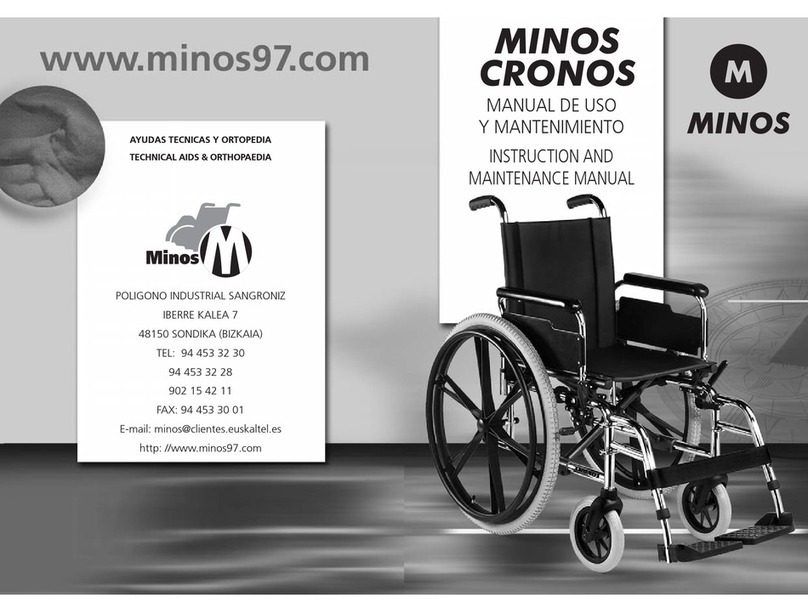
MINOS
MINOS CRONOS Instruction and maintenance manual

Invacare
Invacare TDX SC parts list

Invacare
Invacare Wheelchair Pronto M61 user manual

lifestyle mobility aids
lifestyle mobility aids M170-3-416SF operating instructions

Maximex
Maximex Secura Premium 23556 Assembly instructions
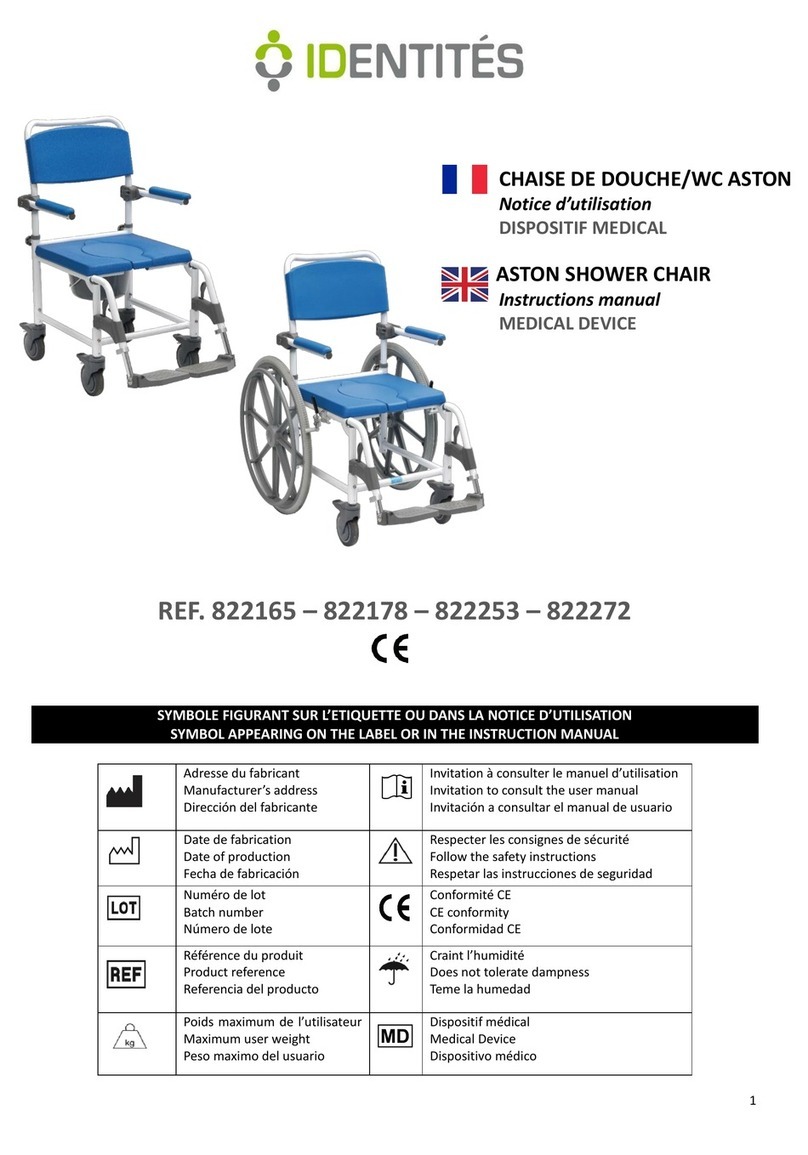
identités
identités Aston 822165 instruction manual

Sunrise Medical
Sunrise Medical QUICKIE SOPUR Nitrum Directions for use
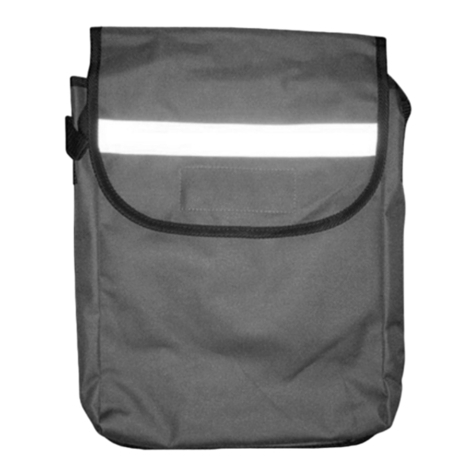
aidapt
aidapt VA135S Fitting and Maintenance Instructions
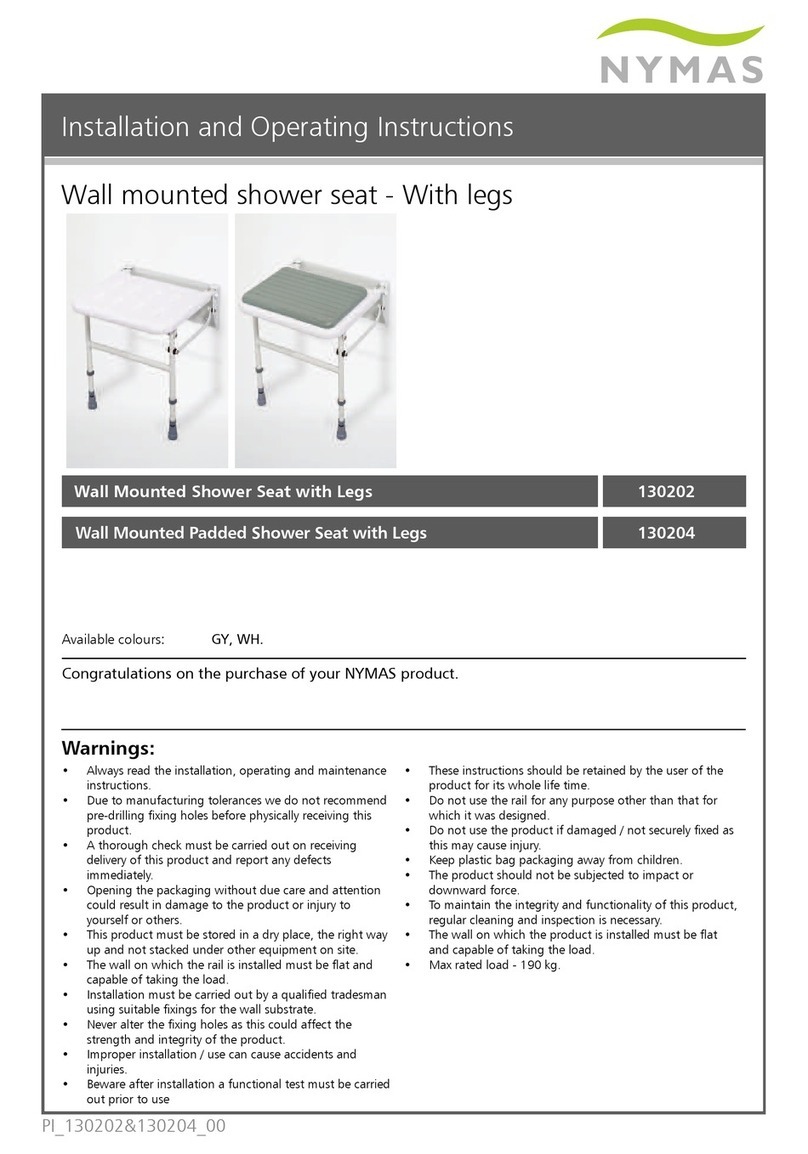
NYMAS
NYMAS 130202 Installation and operating instructions

Permobil
Permobil ConnectMe M400 owner's manual

Roltec
Roltec Viper user manual
